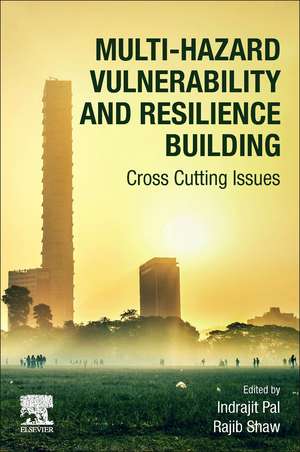Multi-Hazard Vulnerability and Resilience Building: Cross Cutting Issues
Editat de Indrajit Pal, Rajib Shawen Limba Engleză Paperback – 21 mar 2023
- Provides foundational knowledge on integrated disaster vulnerability and resilience building
- Brings together disaster risk reduction and resilience scientists, policy-makers, and practitioners from different disciplines
- Includes case studies on disaster resilience and sustainable development from a multi-disciplinary perspective
Preț: 740.31 lei
Preț vechi: 968.98 lei
-24% Nou
Puncte Express: 1110
Preț estimativ în valută:
141.66€ • 151.48$ • 118.11£
141.66€ • 151.48$ • 118.11£
Carte tipărită la comandă
Livrare economică 10-24 aprilie
Livrare express 13-19 martie pentru 88.32 lei
Preluare comenzi: 021 569.72.76
Specificații
ISBN-13: 9780323956826
ISBN-10: 0323956823
Pagini: 412
Dimensiuni: 152 x 229 x 22 mm
Greutate: 0.55 kg
Editura: ELSEVIER SCIENCE
ISBN-10: 0323956823
Pagini: 412
Dimensiuni: 152 x 229 x 22 mm
Greutate: 0.55 kg
Editura: ELSEVIER SCIENCE
Cuprins
1. An overview of vulnerability and resilience building in the Asia Pacific region
2. Opportunities and challenges farmers face when Using indigenous knowledge to adapt to climate change in sustainable development in Mekong Delta, Vietnam (A case study in An Giang province)
3. Development of a disaster and climate risk ATLAS in Bangladesh: Methodology for quantification of risk
4. Sustainability assessment methodology for residential building in urban area - a case study
5. Comparison of the vulnerability assessment of step-back configuration and set-back configuration structures on hill slopes
6. A proposal for disaster risk management in the local level: lesson learned from earthquake prone area in Sengon village, Central Java, Indonesia
7. Community resilience for disaster risk reduction by engaging local governance in Bihar (India)
8. A working strategy for preparedness in Kerala schools: a suggestive study
9. Integrating indigenous knowledge with science to suitably tackle disasters due to climate and environmental change: an overview of the progress and way forward
10. Target E of Sendai Framework: current status and how to complete by 2022 end
11. Predict the critical load of rectangular concrete-filled steel tube columns with ultra high strength concrete with software ANSYS
12. Time-dependent reliability system of the continuous steel beam I-shapes with corrosion damage
13. An extensive study on damage assessment of earthquake-affected buildings in Nepal
14. Modeling soil erosion: Samanalawewa watershed, Sri Lanka
15. Efficient earthquake intensity measures for probabilistic seismic demand models of skewed RC bridges
16. Time-frequency analysis of ground motions from the 1999 Chamoli earthquake
17. Mainstreaming disaster risk management technical and vocational education and training (DRM-TVET) program in higher education institutions: flexible ladderized capacity building model amid COVID-19
18. Extreme flood analysis for Lower Indus Basin, Pakistan study under disaster risk reduction
19. Change in cropping pattern and soil health in relation to climate change and salinity in coastal Bangladesh
20. Strengthening capacity for disaster resilience of rural women in Fiji
21. Foundation of indigenous knowledge theory for disaster risk reduction
22. Critical infrastructure resilience in Eastern Economic Corridor of Thailand - a review
2. Opportunities and challenges farmers face when Using indigenous knowledge to adapt to climate change in sustainable development in Mekong Delta, Vietnam (A case study in An Giang province)
3. Development of a disaster and climate risk ATLAS in Bangladesh: Methodology for quantification of risk
4. Sustainability assessment methodology for residential building in urban area - a case study
5. Comparison of the vulnerability assessment of step-back configuration and set-back configuration structures on hill slopes
6. A proposal for disaster risk management in the local level: lesson learned from earthquake prone area in Sengon village, Central Java, Indonesia
7. Community resilience for disaster risk reduction by engaging local governance in Bihar (India)
8. A working strategy for preparedness in Kerala schools: a suggestive study
9. Integrating indigenous knowledge with science to suitably tackle disasters due to climate and environmental change: an overview of the progress and way forward
10. Target E of Sendai Framework: current status and how to complete by 2022 end
11. Predict the critical load of rectangular concrete-filled steel tube columns with ultra high strength concrete with software ANSYS
12. Time-dependent reliability system of the continuous steel beam I-shapes with corrosion damage
13. An extensive study on damage assessment of earthquake-affected buildings in Nepal
14. Modeling soil erosion: Samanalawewa watershed, Sri Lanka
15. Efficient earthquake intensity measures for probabilistic seismic demand models of skewed RC bridges
16. Time-frequency analysis of ground motions from the 1999 Chamoli earthquake
17. Mainstreaming disaster risk management technical and vocational education and training (DRM-TVET) program in higher education institutions: flexible ladderized capacity building model amid COVID-19
18. Extreme flood analysis for Lower Indus Basin, Pakistan study under disaster risk reduction
19. Change in cropping pattern and soil health in relation to climate change and salinity in coastal Bangladesh
20. Strengthening capacity for disaster resilience of rural women in Fiji
21. Foundation of indigenous knowledge theory for disaster risk reduction
22. Critical infrastructure resilience in Eastern Economic Corridor of Thailand - a review
